MUSEUM HAPPENINGS - August 2025
Uranium Exhibit PART II Unveiled
by Moab Museum Staff
|
|  U92: Moab’s Uranium Legacy explores the geologic, political, and cultural stories surrounding uranium mining, both globally and locally. Open through the end of 2025, the Moab Museum is proud to announce the second phase of our Uranium exhibition. U92: Moab’s Uranium Legacy explores the geologic, political, and cultural stories surrounding uranium mining, both globally and locally. Open through the end of 2025, the Moab Museum is proud to announce the second phase of our Uranium exhibition.
U92: Aftermath highlights the aftermath of this profound chapter in history. Humans and the ecosystem have suffered catastrophic effects, some paving the way for improved safety and environmental policies. Today, this “miraculous” mineral offers a widely recognized clean energy source, and its extraction can be conducted responsibly if implemented by policy. The exhibit poses the question: What changes are in place today to ensure a future in utilizing this powerful mineral is advantageous for all communities, and these beautiful lands?
Dr. Tommy Rock, a multidisciplinary researcher of the Navajo Nation, introduced the exhibition, presenting his research on water monitoring and bioaccumulation in local flora and fauna. Check out the exhibition to learn directly from his research and the research of others!
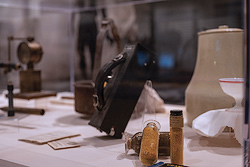 Moab Art Walk – Friday, August 1st at 5 pm Moab Art Walk – Friday, August 1st at 5 pm
On Friday, August 1st, from 5-8 pm for the Moab Art Walk, experience Uranium After Dark, a multimedia installation that features archival photographs and footage interspersed throughout U92: Moab’s Uranium Legacy exhibition. Bring family and friends and prospect for your very own glow rocks with a black light!
This event is FREE to attend! Stop by the other venues along the way, including the Moab Arts Center, Grand County Public Library, Gallery Moab, Summit Sotheby’s – Moab, Moonflower, and the Sundry!
Collections Stories
This summer, the Museum launched Collections Stories, a collections-specific video series recording conversations with object donors or legacy family members about objects in our stewardship. Check out the stories online at moabmuseum.org or find us on social media to learn more about specific objects within the Collection! There is an incredible array of stories from our little valley – let us know what else you want to hear!
For the remainder of August, we’ll be taking a programmatic break, but the Museum will be open as usual from 9 am-5 pm, Tuesday-Saturday! And finally, remember that the Museum’s community survey is LIVE! Share your feedback, what you want to learn, and from whom you want to hear in 2025 and into 2026 at: https://forms.gle/q59FKXhDZv8EcQc96.
For more information, visit
moabmuseum.org
|
Utahraptor State Park is Open!
The Utah Historical Society
|
|
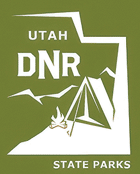 Visit Utah’s newest state park! Utahraptor State Park holds a unique place within our State Park system. Not only is it located in one of the most popular outdoor recreation destinations in Utah, but the rich history of this land spans back to World War II and even further to the time of the dinosaurs. Visit Utah’s newest state park! Utahraptor State Park holds a unique place within our State Park system. Not only is it located in one of the most popular outdoor recreation destinations in Utah, but the rich history of this land spans back to World War II and even further to the time of the dinosaurs.
Utahraptor State Park is roughly 15 miles northwest of Moab in the Dalton Wells and Willow Springs area of Grand County, where Utah’s most famous dinosaur was discovered. Visitors can access the visitor center 9am to 5pm year-round and view exhibits about the former Dalton Wells Civilian Conservation Corps (CCC) Camp, the World War II era Moab Citizen Isolation Center, and learn about the park’s important paleontological discoveries. Stay the night in the campground with partial hook up sites, access clean restrooms, and experience the nearby OHV and mountain bike trail systems. Come create lasting memories with family and friends and experience all that Utahraptor State Park has to offer.
Campsite reservations, day use pass information and more can be found at stateparks.utah.gov/parks/utahraptor/
| Utahraptor State Park’s Interpretive Trail of Two Camps |
|
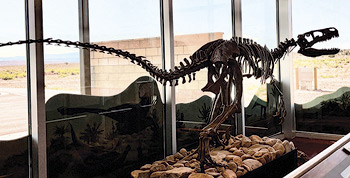 On a warm, breezy morning I drive up to Utah’s newest state park to hike the Dalton Wells Civilian Conservation Corps (CCC) Camp and Moab Internment Camp Trail, a path through the ghostly wake of two camps created by two Executive Orders. The Dalton Wells CCC Camp, created through President Franklin D. Roosevelt’s Executive Order 6101 in 1933, housed unemployed young men to complete various projects in our area. A decade later, Roosevelt’s Executive Order 9066 caused those abandoned camp buildings to get repurposed to incarcerate innocent Japanese-American citizens. On a warm, breezy morning I drive up to Utah’s newest state park to hike the Dalton Wells Civilian Conservation Corps (CCC) Camp and Moab Internment Camp Trail, a path through the ghostly wake of two camps created by two Executive Orders. The Dalton Wells CCC Camp, created through President Franklin D. Roosevelt’s Executive Order 6101 in 1933, housed unemployed young men to complete various projects in our area. A decade later, Roosevelt’s Executive Order 9066 caused those abandoned camp buildings to get repurposed to incarcerate innocent Japanese-American citizens.
I head north out of Moab up US 191 about 14 miles and turn right/east toward the Utahraptor State Park Visitor Center, just as it opens at 9 a.m. After examining the unique historical and paleontological displays inside, I proceed along the main paved road, follow the “Historic Site” signs, and travel a gravel road to the parking 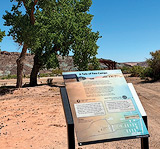 area. (Park designers continue to extend and plan more hiking, mountain bike, and OHV trails.) This sandy Tale of Two Camps trail is flat, austere, desolate, and dotted with black brush and other high-desert shrubs plus occasional prickly pear cacti in full, saffron-yellow bloom. But this trail is not primarily about what visitors can see, it is more about imagining and remembering governmental responses to two major historical events. area. (Park designers continue to extend and plan more hiking, mountain bike, and OHV trails.) This sandy Tale of Two Camps trail is flat, austere, desolate, and dotted with black brush and other high-desert shrubs plus occasional prickly pear cacti in full, saffron-yellow bloom. But this trail is not primarily about what visitors can see, it is more about imagining and remembering governmental responses to two major historical events.
The first crisis involved the Great Depression and southeastern Utah grazing and erosion,including a huge flood that had tore through Moab in 1932. In response to these and other natural resource issues, camps were organized for projects at Dalton Wells, Warner Lake, Rotary Park,and a site for constructing a southern entrance into Arches. At Dalton Wells, wood-frame and tarpaper barracks housed around 200 men between the ages of 18 and 25. They earned paychecks as they made range improvements on stock trails, springs, wells, and ponds; poisoned prairie dogs that competed with stock for food; plus built corrals, fences, dams, roads, and bridges, many of which are still in use today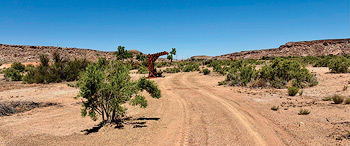 . .
The second crisis was ten years later after the United States declared war on Japan after its attack on the U.S. Pacific Fleet at Pearl Harbor, Oahu, Hawai’i. That response involved rounding up Japanese-American families, without hearings or benefit of counsel, and jailing them in multiple western high-desert concentration camps. In January 1943, a train pulled into the station near present-day Thompson Springs, Utah, with 16 American male citizens of Japanese ancestry who were then trucked to the closed-up Dalton Wells CCC camp. Four months later, all were then transferred to an abandoned Indian school in Leupp (pronounced “loop”), Arizona.
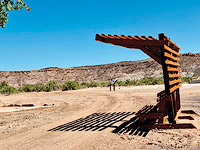 Fifty years after that internment, paleontologists dug up the remains of Utahraptor ostrommaysorum, now Utah’s state dinosaur and this state park’s namesake. Utahraptor lived in this area’s semi-arid floodplain 130 to 125 million years ago. Over 20 feet long and weighing around 1,100 pounds, this raptor’s size and large sickle claws made it a major carnivore of our region. Paleontologists continue to work at the Dalton Wells quarry (north of the two camps’ site), marking it as one of the world’s most diverse bonebeds of the Early Cretaceous Epoch. Fifty years after that internment, paleontologists dug up the remains of Utahraptor ostrommaysorum, now Utah’s state dinosaur and this state park’s namesake. Utahraptor lived in this area’s semi-arid floodplain 130 to 125 million years ago. Over 20 feet long and weighing around 1,100 pounds, this raptor’s size and large sickle claws made it a major carnivore of our region. Paleontologists continue to work at the Dalton Wells quarry (north of the two camps’ site), marking it as one of the world’s most diverse bonebeds of the Early Cretaceous Epoch.
The CCC/Internment interpretive trail along the western bank of Courthouse Wash is about the width of a single car lane and is lined with multiple shade structures. The CCC boys had even organized their own hiking club, visiting various features of our area. As I read the handsomely prepared information signs, I reflect on how the CCC program saved many men and their families from financial ruin. The despair of the Japanese-American men incarcerated here, however, is a cause for sober reflection. Facing financial disaster and certainly not doing any recreational hiking, these men were denied livelihoods and basic rights of citizenship. They do,however, now get a respectfully curated remembrance along this windswept space.
|
|
|